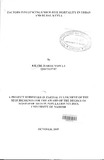| dc.description.abstract | Under five mortality in Kenya has continued to rise since 1989 from 90.9 deaths per 1000 live births to 115 per 1000 live births in 2003, making it improbable that the MDG target of reducing child mortality by two thirds by 2015 will be achieved. It is estimated that approximately, eight out of each 100 live births die before their first birth day, representing huge wastage of potential manpower (CBS, 2004).
Differentials by place of residence from the 1989, 1993, 1998 and 2003 KDHS show that under five mortality rate has remained higher in rural areas than in urban areas. In 1989, urban and rural under five mortality was 89 and 91.2 respectively, 1993 was 75.4 urban and 95.6 rural, 1998 it was 88.3 for urban and 108.6 for rural, and in 2003 it was 93 for urban and 117 for rural areas.
The objective of this study was to examine the determinants of under five mortality in urban and rural Kenya. It specifically sought to establish the effects of some socioeconomic, bio-demographic, socio-cultural and environmental factors on under five mortality in urban and rural areas . The study utilized the 2003 Kenya Demographic and Health Survey (KDHS) data. Out of 8,717 eligible women, 8,195 women were successfully interviewed.
The data was collected from women aged between 15 and 49 years in Kenya, on children born in the three or five years preceding the survey date either dead or surviving. The number of observations at this level was 5949 (1534 for urban and 4415 for rural) representing the number of live births born for the interviewed women in the period of five years preceding the survey. The main study variables were; maternal level of education, wealth index, maternal occupation, maternal age at first birth, birth order, preceding birth interval, source of drinking water and type of toilet facility while the dependent variable was under five mortality.
The study used a conceptual framework developed from Mosley and Chen framework for the analysis of infant and child mortality. To operationalise this conceptual framework, under five mortality was taken as the dependent variable and several socio-economic, bio-demographic, socio-cultural and environmental variables were included as the independent variables. The main methods of analysis were bivariate analysis, which was used to test the levels of correlation between under five mortality and the independent variables and Cox's proportional hazard model used to measure the net effect of the independent variables on under five mortality.
The results of the bivariate analysis revealed significant associations between maternal education, marital status and under five mortality in the urban areas while for the rural areas, maternal education, preceding birth interval and source of drinking water were statistically significant. However, occupation, wealth index, maternal age, birth order, religion and type of toilet were not statistically significant in this study in both the urban and rural areas. The results of the multivariate analysis revealed that maternal education and marital status were significantly associated with under five mortality in the urban areas while preceding birth interval, source of drinking water and maternal education were significantly associated with under five mortality in the rural areas.
The main policy recommendation for this study is the integration of under five survival programmes with family planning programmes especially in the rural areas to lengthen birth intervals in order to lower under five mortality associated with short birth intervals and promotion of education of the girl child. Further studies need to be conducted to determine the mechanisms through which socioeconomic and some bio-demographic factors influence under five mortality in urban and rural Kenya, since they were not clear in this study. | en_US |

